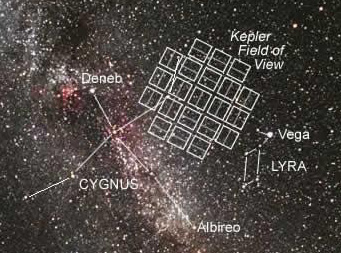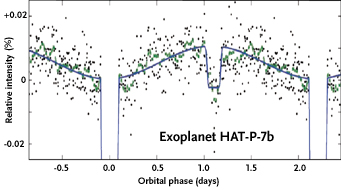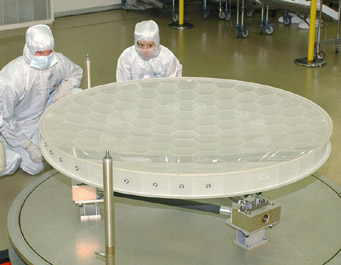It’s a rich universe out there.
The Kepler spacecraft has found signs of planet silhouettes crossing the faces of more than 700 stars, NASA announced on Tuesday. Most of these "planet candidates" still await confirmation by followup studies from the ground, and Kepler science team leader William Borucki (NASA/Ames Research Center) says that as many as half of them may prove to be false alarms. But already the sheer statistics are telling a lot. In particular, it looks like the universe is even richer in small planets than giant ones.

Kepler's 42 detector chips stare continuously at a rich area of the summer Milky Way, monitoring the light of 156,097 selected stars virtually nonstop. The mission should run for at least 3½ years.
NASA / Carter Roberts
Kepler is watching the brightnesses of 156,097 selected stars in Cygnus and Lyra (field at right) for slight dips in their light caused by orbiting planets crossing in front of them. The latest batch of results is Kepler’s second data release. It expands enormously on the first, which the team issued in January when it announced Kepler’s first five confirmed planets.
The new finds are being called “candidate” planets because it's not enough just to see tiny dips in a star’s brightness at regular intervals. False alarms are often caused by starspots or other stellar surface activity, grazing eclipsing binary stars, or a separate eclipsing binary pair near a target star.
The gold standard for confirming an exoplanet is to find a tiny, periodic wobble in the star’s radial velocity in proper sync with the transits. A gravitational wobble not only confirms the planet’s existence but tells its mass. However, this takes many repeated observations with a big telescope and a single-purpose spectrograph that can measure Doppler shifts as small as one part in a hundred million. It isn't fast or easy.
For the new data release, published on May 25th and announced by NASA on June 14th, the Kepler team used a mere 33.5 days of observations near the start of the mission one year ago. During that time Kepler saw 12,000 suspicious brightness dips among its stars. Using these, the team sorted out 706 stars with promising planet candidates. Even if only half of them turn out to be real, the net would be about 300 or 400 new worlds.
That compares with the 461 exoplanets that astronomers have found and confirmed since the first were discovered in 1992.

As soon as Kepler was up, early test observations revealed the brightness dips of the known exoplanet HAT-P-7b passing both in front of (left and right) and behind its star (center). The planet orbits so close to the star that its brilliantly lit dayside contributes a measurable trace to the light of the whole system. The light curve's gradual rise and fall results from the planet's changing phase during its 2.2-day orbit.
W. Borucki & others / Science
Playing Close to the Vest
Of the 706 candidates, Borucki’s team released the identities of only 306. The team is holding back the 400 most interesting ones to do its own followups. These include all the cases involving bright stars (which offer the highest-quality data), and all the planets that seem to be as small as 1½ Earth diameters — or less. The team will do ground-based followups on these during the summer and fall observing season for the Cygnus-Lyra region. The group will report the results in February 2011.
Holding back “proprietary” data for so long — beyond the one year normally allowed for NASA investigators — has raised controversy in the exoplanet community and among scientists generally, as told in a June 14th New York Times article. The team argued successfully that to do the best ground-based followups, it deserved a full observing season for the most interesting planets before letting the rest of the world join the confirmation chase.

The honeycombed blank for Kepler's primary mirror, 36 inches (95 cm) in aperture.
Ball Aerospace
The team published many statistics about the 306 candidates it made public. The most important trend is that transiting planets clearly become more numerous at smaller sizes. “Most candidate planets [seen by Kepler] have radii less than half that of Jupiter,” reports Borucki. Mathematically, the rule seems to be half the diameter means you find four times as many. This hints that even smaller, Earth-size planets will turn out to be very abundant indeed.
Also among the released candidates are four stars that appear to have two planets crossing their faces. Another one has three. These would be the first known multi-transit systems.
Read Borucki’s full summary of these and other findings, with the identities of the 306 released candidate stars.
 5
5
Comments
Mike Emmert
June 18, 2010 at 4:28 pm
I thought that was the whole point of the survey!
This initial release will also not include those candidates with an orbital period of ~ a year, in other words, these are all very hot and inside the habitable zone.
But, I'm glad they released Something. Time to hunker down and exercise patience.
One thing I noticed in the NASA paper is the "Neptunes" were quite common very, very close to stars, and then after about a four day orbital period, dropped off radically. I think the Neptunes might be the stripped cores of larger planets that got into highly eccentric orbits grazing the star, then were heated by the same tides that circularized the orbits. Distilled iron, in other words. Well, we'll see.
You thought the Pluto debate was bad? Wait'll you see the planet definition changes as a result of this mission!
You must be logged in to post a comment.
Stefano Delmonte
June 21, 2010 at 11:46 am
History did teach us the innocent we've been along the time thinking about the earth's uniqueness.
The first results of exoplanet quest is revealing that rocky planets and maybe even life is only one step more in a solar system evolution.
Thanks ESA-NASA-JAXA....
You must be logged in to post a comment.
Rudy
June 22, 2010 at 5:37 pm
What about planetary systems that don't present with their ecliptic plane edge-on so that the host star is shadowed? Are such exoplanets identified/accounted for by wobble?
You must be logged in to post a comment.
Ken Winters
June 22, 2010 at 6:10 pm
Yes, most of the 300 some exoplanets already known have been identified by wobble.
You must be logged in to post a comment.
You must be logged in to post a comment.